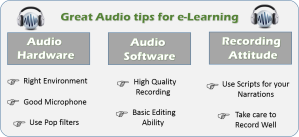Last week’s Articulate e-Learning challenge engaged e-learning designers in sharing great audio tips for building great e-Learning courses. Since I am very new to e-learning, I have not done much of audio narration nor included audio in any of my courses.
However, it was a great week learning so much from others as they share their audio tips and audio setup. In trying to do a summary of all tips, I put them under three headings…
1. Audio Hardware
Here the first hardware important is the quiet and conducive recording environment. Editing and other sound improvement tweaks is possible but all dependent on the original recording. So record in a quiet environment, maybe at night when kids and pets are asleep and the streets are quiet as well. Put up a ‘Recording On, don’t disturb’ notice on the door to avoid ‘necessary but avoidable calls’ like someone put it.
Next to the recording environment is getting a good microphone. Two basic types of microphones were talked about – Headset mics and Desktop USB mics. The quality of your audio depends largely on the quality of your microphone, so it’s worth it investing on a good mic. Among others, the Samson Go mic, Blue Yeti and the Snowball ICE mics are good microphones.
Finally is the use of Pop filters to block and eliminate Plosives. There are a number of them in the market but you can make one yourself.
2. Audio Software
The next component to producing great audio is using a good audio recording and editing software. There are a number of them available ranging from free Audacity to GarageBand for Mac users, Camtasia etc. Just get a software that can do some noise cancellation and compression.
3. Recording Attitude
Scripting is very important. Write a script for every scene and practice saying every word well with the correct pronunciation. Take care to do a proper recording, put your mind into it. Talk as though you are seeing your learners before you. Like Tom says, Relax your learners are not going to listen in a studio!
So when next you need to incorporate audio narration into your e-learning course, these tips will surely be of help.


These are some great valuable tips for e-learning audio course development. Thanks for such a great post
Yes…and I’ve made use of these tips as I increasingly work with audio. I appreciate your comment and thanks for stopping by!